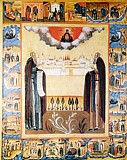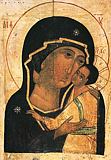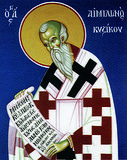

| Previous day | Next day |
| Old Style
August 8
|
Wednesday |
New Style
August 21
|
|
9th Week after Pentecost.
Tone 7.
Успенский пост. |
Monastic rule: xerophagy (bread, uncooked fruits and vegetables).
|
Afterfeast of the Transfiguration. ![]() St. Emilian the Confessor, bishop of Cyzicus (815-820).
St. Emilian the Confessor, bishop of Cyzicus (815-820). ![]() First (1566) and second translations of the relics of Sts. Zosimas and Sabbatius, of Solovki (1992).
First (1566) and second translations of the relics of Sts. Zosimas and Sabbatius, of Solovki (1992).
St. Myron, archbishop of Crete (ca. 350). St. Gregory, iconographer, of the Kiev Caves (12th c.). St. Gregory of Sinai (Mt. Athos) (14th c.). Martyrs Eleutherius and Leonides, of Constantinople, and many infants with them (4th c.). St. Philaret of Ichalka, Ivanovo (1913). Translation of the relics of St. Herman of Solovki (1992). Uncovering of the relics of St. Barlaam of Chikoisk Monastery (Siberia) (2002).
New Hieromartyr Joseph (Baranov), hieromonk of the Tolga Monastery (Yaroslavl) (1918). New Hieromartyr Nicholas Prozorov, priest, of Pokrovskoye (1937). New Hieromartyr Nicodemus (Krotkov), archbishop of Kostroma (1938).
“Tolga” Icon of the Most Holy Theotokos (1314) (1314).
Martyr Gormizdas of Persia (418). St. Zosimas the Sinaite, of Tuman Monastery, Serbia (14th c.). St. Gregory, wonderworker, of the Kiev Caves (14th c.). New Martyr Triandaphyllus of Zagora, at Constantinople (1680). New Martyr Anastasius (Spaso) of Strumica, at Thessalonica (1794). Monk-martyr Euthymius, abbot, of the Monastery of St. John the Baptist, at Gareji, Georgia (1804). St. Jacob, monk, of New Tuman Monastery (Serbia) (1946).
Thoughts for Each Day of the Year
According to the Daily Church Readings from the Word of God
By St. Theophan the Recluse

Wednesday. [I Cor. 13:4-14:5; Matt. 20:1-16]
In the parable about the hirelings, even he who worked only one hour was rewarded equally to the others by the master of the house. The hours of the day in this parable is an image of the course of our life. The eleventh hour is the final time in this life. The Lord shows that even those who lived without working for Him up to that moment can start to work and please Him no less than others. Therefore, old age is no excuse; let no one despair, supposing that there is no point in starting to work. Start, and do not be cowardly; the Lord is merciful; He will give you all that He gives others, here, according to the measure of grace, and there, according to the rank of truth. Just have more fervour, and grieve more contritely about the carelessness in which almost all of your life was spent. You will say, the master of the house called those in the parable. So, let the Lord call me. But isn’t He calling? Could it really be that you do not hear the voice of the Lord in the Church, saying, come unto Me all ye, and the Apostles’ call, as though God did beseech you by us: we pray you in Christ’s stead, be ye reconciled to God (II Cor. 5:20).
Articles
 St. Emilian the Confessor, Bishop of CyzicusSaint Emilian was a zealous defender of the holy icons during the reign of Emperor Leo the Armenian. |
 Venerable Zosimas the Abbot of SolovkiSaint Zosimas, Igumen of Solovki a great luminary of the Russian North, was the founder of cenobitic monasticism on Solovki Island. |
 New Martyr Triandaphyllus of Stara ZagoraHe was only fifteen years old when he received the crown of victory from Christ. |









